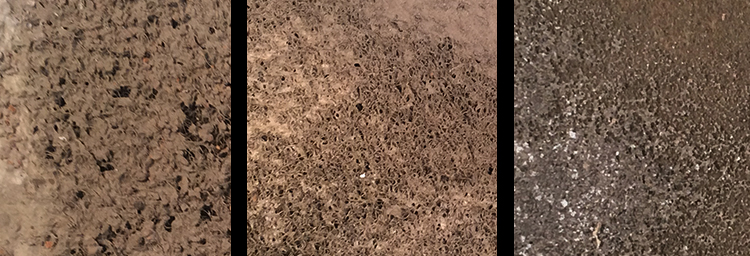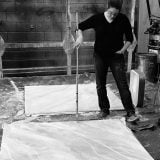Brigitte Bechtel is a scenic artist whose paintbrushes have taken her from Boston, MA to Tucson, AZ, and beyond! While working at The Arizona Theatre Company, she discovered a delightful new challenge. ATC has venues both in Tucson and Phoenix, about 110 miles apart, and each production of ATC’s season performs in both venues. That means every ATC set design needs to be planned, built, and executed as a touring production. Brigitte developed one particular scenic technique that she learned while facing this challenge – how to create realistic dirt that travels well and installs easily. Below, she shares how she put that technique to work on two different productions.
August Wilson’s Fences
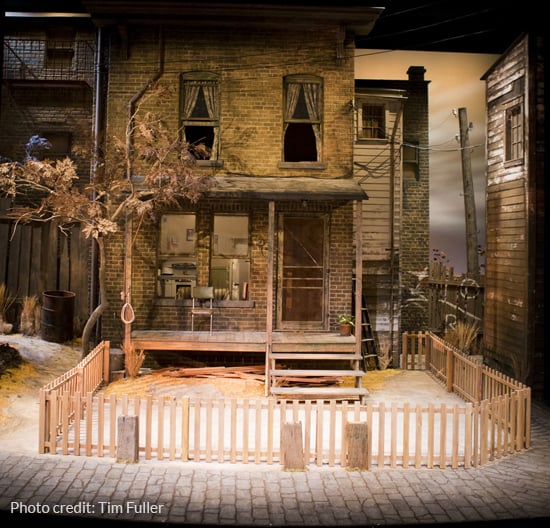 Fences, 2016, Arizona Theatre Company
Fences, 2016, Arizona Theatre Company
While prepping Arizona Theatre Company’s 2016 production of Fences, Technical Director Matt Saxton and I analyzed the aesthetic needs for Scenic Designer Vicki Smith’s set design against the travel requirements, resources, and build time available to us. Matt and I wanted to be able to travel the yard in as few pieces as possible in order to reduce seams and touchup time onstage, while also creating compact components that would pack well into a 53’ trailer. We began experimenting with varying types of carpeting as a “yard base.”
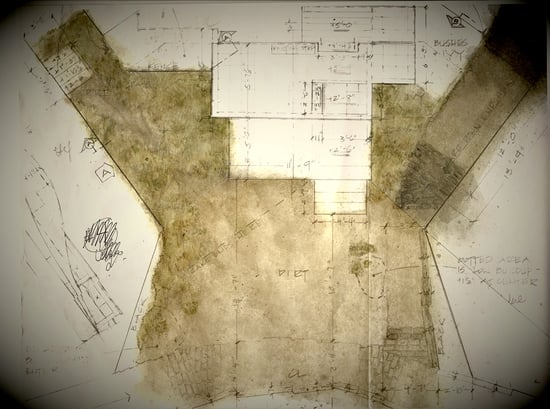 Vicki Smith’s Floor Rendering
Vicki Smith’s Floor Rendering
The challenge was finding a carpet that would satisfy our needs. We needed it to:
- Lay nicely over the topographic structure underneath
- Take the faux dirt and grass treatments well
- Withstand several runs, in multiple cities
We sourced several local commercial carpet providers, online carpet sources, and even investigated automotive carpeting. While the automotive carpeting contoured and took the treatment the best, it was not available in wide widths, which made it cost prohibitive. The standard commercial carpet had a backing that was too stiff to contour the topography appropriately. Ultimately, we determined a low-nap, indoor/outdoor carpet in a 12’ width satisfied our needs.
I created full-scale samples based on Vicki’s deck rendering, notes from her drafting, and our preliminary phone calls. I created areas of “packed” dirt and “loose” dirt by using varying ratios of elastomeric for flexibility, plus scenic paint and texture additives (walnut shells, vermiculite, etc.) for the dirt base. Using this mixture as the mid-tone base color, we worked in lighter and darker areas as needed. After a series of photos and phone calls, Vicki and I zeroed-in on the right looks for each area of the yard. From there, it was simply a matter of following Vicki’s excellent map and painting in the “packed dirt” and “loose dirt” areas into the correct place onstage.
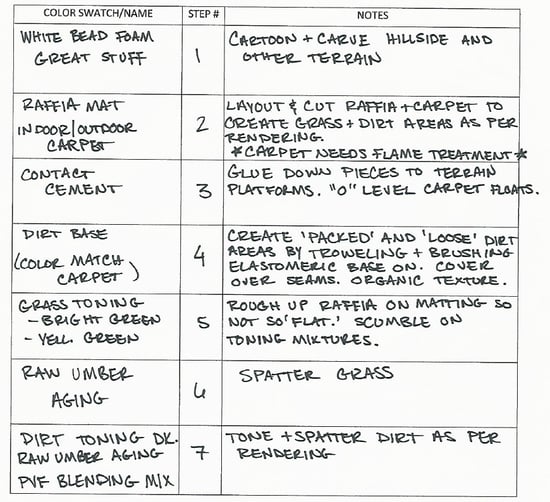 The process sheet for the Fences yard.
The process sheet for the Fences yard.
Once all of the scenic and prop elements were placed in the theater, we spent thorough time onstage really “settling” these pieces into the yard to give the illusion of age. We took care to age the elements as naturally as possible, taking into consideration how “the climate” might have affected different areas of dirt through many seasons outside. This involved a lot of matching colors to mimic those effects and blending grass and dirt up onto the bottoms of scenic elements.
Materials:
- Shaw Softscape II Outdoor Carpet – Color: Natural
- White elastomeric roof coating for smooth “packed dirt”
- White elastomeric patching compound and roofing sealant for textured “loose dirt”
- Ground walnut shells
- Rosco Off Broadway Scenic Paint
#5354 Burnt Umber & #5357 Raw Umber
Various consistencies for spattering and toning
Production Credits:
Scenic Design: Vicki Smith
Charge Scenic Artist: Brigitte Bechtel
Scenic Artists: Lydia Lopez, Liz Weibler, Andrea Pratt
Karen Zacarías’ Native Gardens
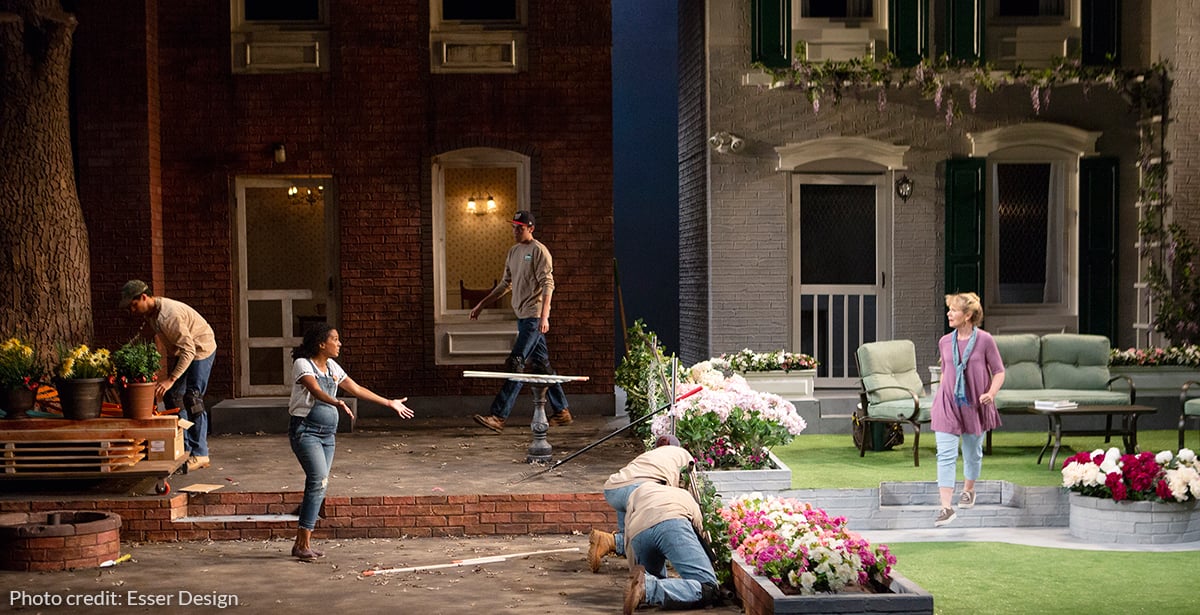 Native Gardens, 2018, Arizona Theatre Company
Native Gardens, 2018, Arizona Theatre Company
When discussing preliminary designs with Scenic Designer Carey Wong for Native Gardens in the summer of 2018, I realized the yard solution we used for Fences could possibly apply. After discussing the process with Technical Director Dominic DeRiso, and after showing Carey some of the process photos from our Fences archive, Carey was quite interested to see this concept applied to his design. I was able to find the same carpet we used in Fences in a mid-tone, which worked well for the Native Gardens color palette.
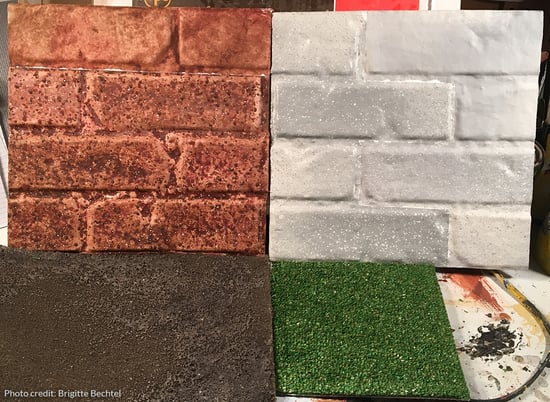 The Native Gardens Sample Process
The Native Gardens Sample Process
Because Carey’s dirt yard was more stylized than the Fences yard, we used less of the “packed” dimensional elastomeric dirt and texture additives, and more scenic paint spatters and washes were used in the process to tone the carpet according to Carey’s rendering. There was no underlying topography to contend with in the level, tiered yard of the set design, so the carpet was able to float over the platforming and stage deck in 3 large pieces that could be rolled up and easily placed on a cart for travel. Natural grass, plant, and tree leaves/limb dressings were added by the props team to help create the organic look to the Native Gardens dirt yard.
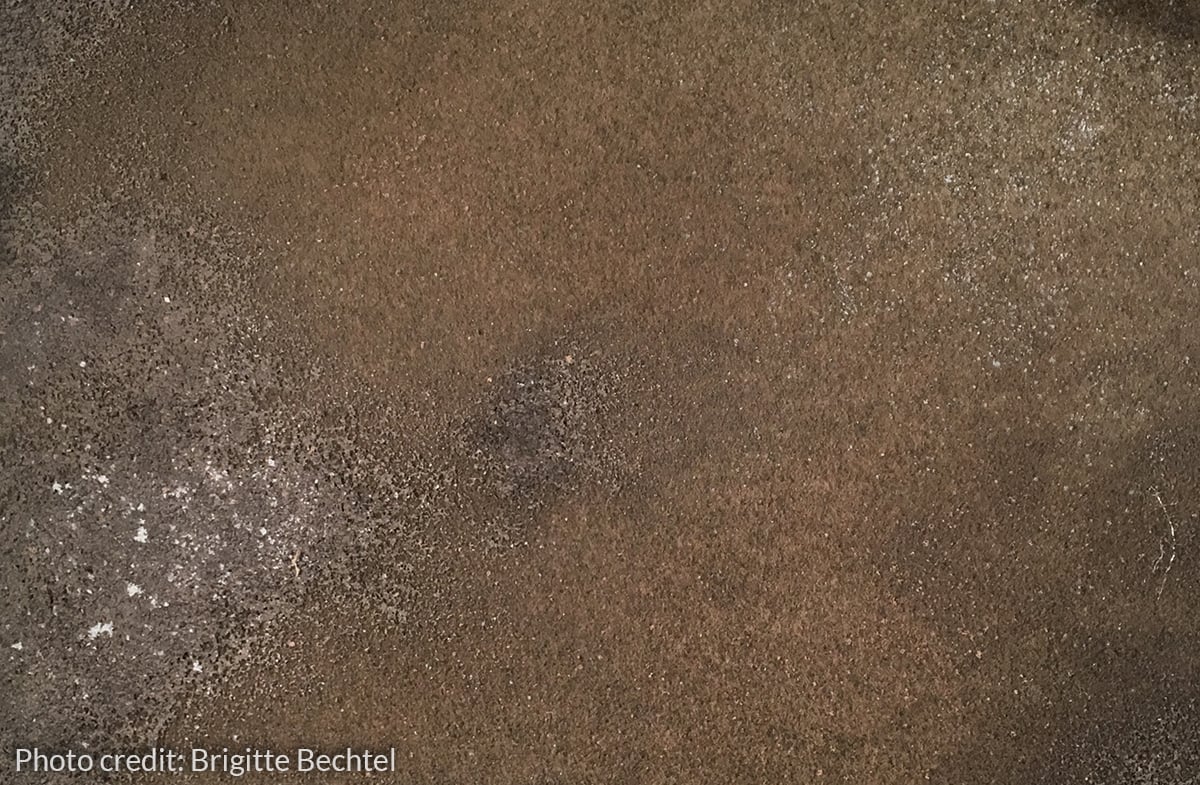 Dirt sample closeup for Native Gardens
Dirt sample closeup for Native Gardens
Flexibility in materials was key throughout the process in order to avoid cracking or peeling due to travel, storage, and handling. It’s worth noting that all of the scenic elements for both of these productions were treated with flame retardants to be in compliance for all venues. In addition, many of the materials used at Arizona Theatre Company are chosen because they are local and readily available. These may differ from brands locally available to your area that are just as good, if not better, for your project.
Materials:
- Shaw Softscape II Outdoor Carpet – Color: Peat
- White elastomeric patching compound and roofing sealant for textured “loose dirt.”
- Ground walnut shells
- Rosco Off Broadway Scenic Paint
#5354 Burnt Umber & #5357 Raw Umber
Various consistencies for spattering and toning
Production Credits:
Scenic Design: Carey Wong
Charge Scenic Artist: Brigitte Bechtel
Assistant Charge Scenic Artist: Mallory Harwell
No matter the show, it is crucial to have a firm understanding of the needs of any paint treatment. Careful planning and proper communication with the designers through sampling is key to addressing the potential challenges you might face. It is always best to stay flexible throughout the process, and do not be afraid to get a little dirty.
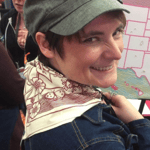 Scenic Artist Brigitte Bechtel’s experiences have also led her on scenic adventures at Cobalt Studios, Emerson College and Mystic Scenic Studios - and she is now the Charge Scenic Artist at Ohio University's School of Theater. To see more of Brigitte’s amazing work, follow her on Instagram: @amascenic, and be sure to check out her portfolio on her website: www.brigittebechtel.com. If you’d like to learn more about the paints she used, explore the Off Broadway Scenic Paint page on the Rosco website.
Scenic Artist Brigitte Bechtel’s experiences have also led her on scenic adventures at Cobalt Studios, Emerson College and Mystic Scenic Studios - and she is now the Charge Scenic Artist at Ohio University's School of Theater. To see more of Brigitte’s amazing work, follow her on Instagram: @amascenic, and be sure to check out her portfolio on her website: www.brigittebechtel.com. If you’d like to learn more about the paints she used, explore the Off Broadway Scenic Paint page on the Rosco website.
This blog article was originally published by the Guild of Scenic Artists inside their Scenic Route blog. Read the original article for a few extra tips and techniques.

